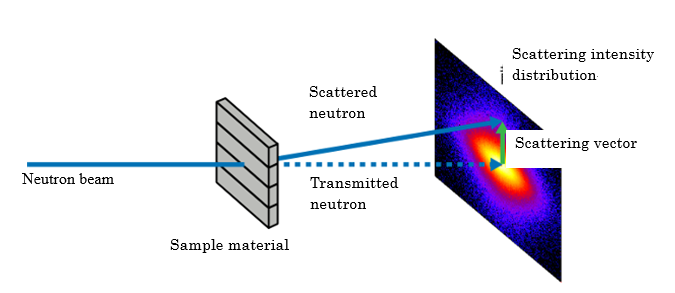New Technique Developed to Quantitatively Evaluate Internal Magnetic Structure of Permanent Magnet Materials
2016.06.30
(2016.11.10 Update)
National Institute for Materials Science (NIMS)
High Energy Accelerator Research Organization (KEK)
A NIMS–KEK joint research team developed a technique to quantitatively evaluate the internal magnetic structure of permanent magnet materials using a neutron beam.
Abstract
- A research team led by postdoctoral researcher Tetsuro Ueno, Elements Strategy Initiative Center for Magnetic Materials (ESICMM), Research Center for Magnetic and Spintronic Materials (CMSM), NIMS, and associate professor Kanta Ono, Institute of Materials Structure Science (IMSS), High Energy Accelerator Research Organization (KEK), developed a technique to quantitatively evaluate the internal magnetic structure of permanent magnet materials using a neutron beam.
- Permanent magnet materials are commonly used in our lives. For example, motors of hybrid and electric vehicles contain neodymium–iron–boron (Nd–Fe–B) magnets. It is feasible to make these motors more efficient, smaller and more energy saving by using high performance permanent magnet materials. To develop such materials, it is vital to identify internal magnetic structures of target materials and determine their relationships to magnetic properties of respective materials. It is already practical to observe magnetic structures on the surfaces of materials using polarizing microscopes and magnetic force microscopes. However, there had been no experimental technique available to quantitatively evaluate materials’ internal magnetic structures.
- The research team developed a technique to quantitatively evaluate the internal magnetic structures of permanent magnet materials by conducting small-angle neutron scattering (SANS) experiments. In these experiments, a technique is used to identify microstructures in sample materials, ranging from several nanometers to several micrometers, by irradiating a neutron beam to a sample and obtaining the intensity distribution of scattered neutrons in the sample. When analysis is performed on SANS measurements, it is assumed that neutron scattering occurs only once due to the internal microstructure of a sample material. However, in reality, neutrons scatter several times inside the material and this phenomenon is called multiple scattering. With respect to permanent magnet materials, conditions conducive to multiple scattering had been unknown, hindering quantitative evaluations of magnetic structures. We recently carried out experiments in which we systematically changed the thickness of Nd–Fe–B nanocrystalline magnet samples and the wavelength of the neutron beam, and found that thicker samples and longer wavelengths are linked to intense scattering. Subsequently, we subtracted multiple scattering effects from the observed SANS intensities and analyzed the corrected data. As a result, we succeeded in quantitative evaluation of the internal magnetic structures of sample materials.
- In future studies, we plan to apply this evaluation technique to various permanent magnet materials for close examination of the relationship between internal magnetic structures and magnetic properties. These studies may accelerate research and development of permanent magnet materials with enhanced performance.
- This research was supported by the Elements Strategy Initiative Center for Magnetic Materials (ESICMM) and the Technology Research Association of Magnetic Materials for High-Efficiency Motors (MagHEM) that were launched to conduct MEXT-commissioned projects.
- This study was published in the British journal Scientific Reports (online version) at 18:00 on June 20, 2016.

Figure: Schematic of a small-angle neutron scattering experiment. The two-dimensional detector measures the intensity distribution of scattered neutrons.
Related files
- Research Center for Magnetic and Spintronic Materials
- Elements Strategy Initiative Center for Magnetic Materials(ESICMM)
Contacts
(Regarding this research)
-
Tetsuro Ueno
Postdoctoral researcher, Elements Strategy Initiative Center for Magnetic Materials (ESICMM), Research Center for Magnetic and Spintronic Materials (RCMSM), NIMS
Tel: +81-29-864-5200 ext. 2515
E-Mail: UENO.Tetsuro=nims.go.jp
(Please change "=" to "@") -
Kanta Ono
Associate Professor, Institute of Materials Structure Science (IMSS),
High Energy Accelerator Research Organization
Tel: +81-29-864-5659
E-Mail: kanta.ono=kek.jp
(Please change "=" to "@")
(Regarding public relations)
-
Public Relations Office
National Institute for Materials Science
1-2-1 Sengen, Tsukuba, Ibaraki, 305-0047, JAPAN
Tel: +81-29-859-2026
Fax: +81-29-859-2017
E-Mail: pressrelease=ml.nims.go.jp
(Please change "=" to "@") -
Saeko Okada
Director, Public Relations Office, High Energy Accelerator Research Organization
1-1 Oho, Tsukuba, Ibaraki, 305-0801, Japan
Tel: +81-29-879-6047
Fax: +81-29-879-6049
E-Mail: press=kek.jp
(Please change "=" to "@")
Same Keywords
-
Launch of a Materials Open Platform for Permanent Magnet by NIMS and Four Magnet Makers
(magnet)
2022.05.30
-
Success in Efficient Fabrication of High-Performance Neodymium Magnets Using Machine Learning
(magnet)
2021.11.15
-
Sm(Fe0.8Co0.2)12 with a Lean Rare Earth Content Exhibits Superb Magnetism
(magnet)
2020.06.10
